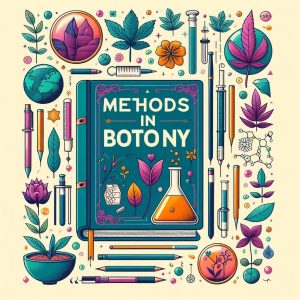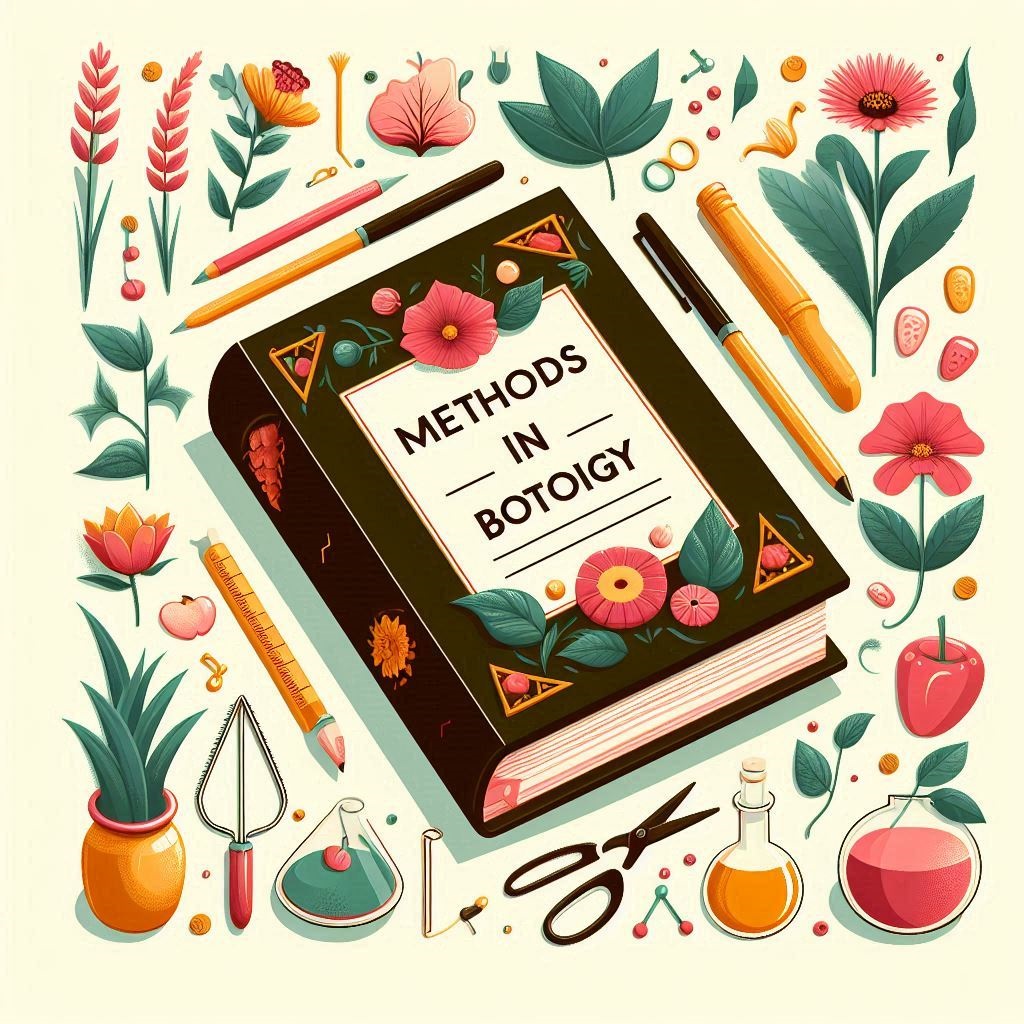Methods in Botany
1. Plant Genetics and Breeding
Modern methods in botany have revolutionized plant genetics and breeding. Techniques such as CRISPR-Cas9 have enabled precise gene editing, allowing scientists to develop crops with desirable traits such as drought resistance and enhanced nutritional value. This method accelerates the breeding process, significantly reducing the time required to develop new plant varieties.
Marker-Assisted Selection
Another powerful method in plant genetics is marker-assisted selection (MAS). MAS uses molecular markers linked to desirable traits to select plants with those traits at an early stage. This technique speeds up the breeding process and increases the accuracy of selecting plants with specific genetic attributes, making it particularly valuable for traits that are difficult to assess visually, such as disease resistance or nutritional content.
Genomic Selection
Genomic selection (GS) is an advanced method that uses genome-wide markers to predict the performance of plants. Unlike traditional breeding methods, which rely on phenotypic selection, GS can evaluate thousands of markers across the genome, making it possible to select the best candidates for breeding programs even before they mature. This approach is particularly useful for complex traits influenced by multiple genes.
Polyploidy Breeding
Polyploidy breeding involves the manipulation of chromosome numbers to develop new plant varieties with enhanced traits. Polyploidy, the condition of having more than two complete sets of chromosomes, can lead to greater genetic diversity, increased vigor, and improved stress tolerance. Many important crops, such as wheat and cotton, are polyploids, and breeding programs often induce polyploidy to exploit these benefits.
Hybrid Breeding
Hybrid breeding is a traditional but still widely used method where two genetically different parent plants are crossbred to produce offspring with superior traits. Hybrid plants often exhibit hybrid vigor or heterosis, resulting in better growth, yield, and resistance to diseases. This method is extensively used in crops like maize and rice, where hybrid varieties have substantially increased productivity.
Genome Editing and Synthetic Biology
The advent of genome editing and synthetic biology has opened new frontiers in plant breeding. These methods allow for the precise insertion, deletion, or modification of genes, enabling the creation of plants with novel traits that would be difficult or impossible to achieve through traditional breeding. For example, genome editing can be used to develop crops with improved nutritional profiles, increased resistance to pests and diseases, and enhanced tolerance to environmental stresses.
Epigenetic Modifications
Epigenetic modifications refer to changes in gene expression without altering the DNA sequence itself. These modifications can be heritable and play a crucial role in plant development and stress responses. Understanding and manipulating epigenetic mechanisms can lead to the development of crops that are better adapted to changing environments, more resilient to diseases, and more productive.

Table of Modern Methods in Plant Genetics and Breeding
| Method | Application | Key Benefit |
|---|---|---|
| CRISPR-Cas9 | Gene Editing | Precise modification of plant genomes |
| Marker-Assisted Selection | Breeding | Early selection of plants with desirable traits |
| Genomic Selection | Breeding | Predicts plant performance using genome-wide markers |
2. Plant Physiology
Understanding plant physiology is crucial for improving agricultural productivity. Methods like chlorophyll fluorescence and gas exchange measurements help researchers study photosynthesis and respiration in plants. These techniques provide insights into how plants respond to environmental stresses, aiding in the development of resilient crop varieties.
Water Relations and Osmotic Regulation
Water is essential for plant life, and understanding how plants manage water uptake and distribution is key to improving crop efficiency. Methods like pressure chamber techniques and osmotic potential measurements allow researchers to study how plants regulate water and solute movement. These methods help in understanding drought tolerance mechanisms and improving water use efficiency in crops.
Nutrient Uptake and Transport
Plants require various nutrients for growth and development. Methods like hydroponic systems and radioisotope tracing are used to study nutrient uptake and transport within plants. These techniques provide insights into nutrient deficiency symptoms, helping in the development of fertilization strategies to enhance crop yield and quality.
Photosynthesis and Energy Conversion
Photosynthesis is the process by which plants convert light energy into chemical energy. Techniques such as chlorophyll fluorescence imaging and gas exchange analysis allow scientists to study the efficiency of photosynthesis under various conditions. Understanding these processes is essential for improving crop productivity and developing plants that can thrive under changing environmental conditions.
Hormonal Regulation
Plant hormones play a critical role in regulating growth and development. Techniques such as mass spectrometry and ELISA (Enzyme-Linked Immunosorbent Assay) are used to quantify and study hormone levels in plants. These methods help in understanding how hormones influence processes like germination, flowering, and stress responses, leading to the development of strategies to enhance plant growth and resilience.
Stress Physiology
Plants are often exposed to various abiotic and biotic stresses. Methods such as transcriptomics and proteomics are used to study how plants respond to stress at the molecular level. These techniques help identify stress-responsive genes and proteins, providing targets for genetic engineering to develop stress-tolerant crops.
Metabolomics
The study of metabolites produced by plants is known as metabolomics. Techniques such as gas chromatography-mass spectrometry (GC-MS) and liquid chromatography-mass spectrometry (LC-MS) are used to analyze the metabolic profiles of plants. These methods provide insights into plant metabolism, revealing how plants produce and utilize energy, and how metabolic pathways are altered under different conditions.
Table of Methods in Plant Physiology
| Method | Application | Key Benefit |
|---|---|---|
| Chlorophyll Fluorescence | Photosynthesis | Analyzing photosynthesis and plant health |
3. Plant Biotechnology
Plant biotechnology employs methods like tissue culture and plant transformation to propagate plants and introduce new genetic material. Tissue culture is essential for producing disease-free plants and rapidly multiplying plant material, while transformation techniques are used to introduce new genes into plants, enhancing their traits and resistance to pests.
Genetic Engineering
Genetic engineering involves the direct manipulation of an organism’s genes using biotechnology. Techniques such as CRISPR-Cas9 allow scientists to make precise modifications to the plant genome. This technology is used to create genetically modified organisms (GMOs) with traits like herbicide resistance, pest resistance, and improved nutritional content. For example, Golden Rice, a genetically engineered rice variety, is enriched with Vitamin A to combat malnutrition in developing countries.
Tissue Culture
Tissue culture involves growing plant cells, tissues, or organs in a sterile environment on a nutrient culture medium. This method is used for cloning plants (micropropagation), conserving endangered species, and producing disease-free plants. Tissue culture also enables the rapid production of large numbers of genetically identical plants from a single parent plant, ensuring uniformity and quality in crops.
Marker-Assisted Breeding
Marker-assisted breeding uses molecular markers linked to desirable traits to select plants that possess those traits. This technique speeds up the traditional breeding process and increases the accuracy of selecting plants with specific genetic attributes. Marker-assisted breeding is especially useful for complex traits controlled by multiple genes, such as drought tolerance, disease resistance, and nutritional quality.
RNA Interference (RNAi)

4. Plant Ecology
Methods in plant ecology include field experiments and remote sensing to study plant interactions with their environment. Remote sensing technology, such as satellite imagery and drones, enables large-scale monitoring of vegetation health, land use changes, and ecosystem dynamics. These methods provide valuable data for conservation and sustainable land management.
Field Surveys and Vegetation Sampling
Field surveys and vegetation sampling are fundamental methods in plant ecology. Researchers collect data on plant species composition, abundance, and distribution within different habitats. Techniques such as quadrats and transects are used to systematically sample vegetation and assess biodiversity. These methods help identify patterns of species distribution and understand the factors driving these patterns.
Remote Sensing and GIS
Remote sensing and Geographic Information Systems (GIS) are powerful tools for studying plant ecology on larger spatial scales. Remote sensing involves the use of satellite or aerial imagery to monitor vegetation cover, land use changes, and habitat fragmentation. GIS allows researchers to analyze spatial data and model ecological processes, such as species distribution and habitat connectivity. These technologies are essential for tracking changes in plant communities over time and assessing the impacts of environmental changes.
Experimental Ecology
Experimental ecology involves manipulating environmental conditions to study their effects on plant communities. Methods such as controlled field experiments and greenhouse experiments allow researchers to test hypotheses about plant responses to variables like nutrient availability, water stress, and competition. These experiments help elucidate the mechanisms driving plant interactions and adaptations in natural ecosystems.
Stable Isotope Analysis
Stable isotope analysis is a technique used to trace the movement of elements through ecological systems. By analyzing the ratios of stable isotopes in plant tissues, researchers can infer information about water sources, nutrient uptake, and trophic interactions. This method is particularly useful for studying plant-water relations and understanding the sources of nutrients in different ecosystems.
Climate Change Studies
Understanding the impacts of climate change on plant communities is a critical area of research in plant ecology. Methods such as long-term ecological monitoring and climate manipulation experiments are used to study how changes in temperature, precipitation, and atmospheric CO2 levels affect plant growth, distribution, and interactions. These studies help predict future shifts in plant communities and inform conservation strategies.
Community Ecology
Community ecology focuses on the interactions between species within a community and the factors that influence their diversity and abundance. Methods such as species interaction networks and biodiversity indices are used to study the relationships between plants and other organisms, such as herbivores, pollinators, and pathogens. These methods provide insights into the structure and functioning of ecosystems, as well as the processes that maintain biodiversity.
Table of Methods in Plant Ecology
| Method | Application | Key Benefit |
|---|---|---|
| Field Surveys | Species Composition and Distribution | Understanding biodiversity and habitat structure |
| Remote Sensing | Large-Scale Vegetation Monitoring | Tracking changes in plant communities over time |
| Experimental Ecology |
5. Phytochemistry
The study of phytochemistry involves methods like chromatography and mass spectrometry to analyze the chemical compounds produced by plants. These techniques are crucial for identifying bioactive compounds that can be used in pharmaceuticals, agriculture, and food industries. Advances in phytochemistry contribute to the discovery of new drugs and the development of natural pesticides.
Extraction and Isolation
The first step in studying phytochemicals is the extraction of compounds from plant tissues. Methods such as solvent extraction, supercritical fluid extraction, and ultrasound-assisted extraction are used to obtain phytochemicals. Solvent extraction involves using solvents like ethanol, methanol, or acetone to dissolve the desired compounds. Supercritical fluid extraction utilizes supercritical CO2 as the solvent, offering a greener alternative with higher efficiency. Ultrasound-assisted extraction uses ultrasonic waves to enhance the extraction process by breaking down plant cell walls, increasing the yield of phytochemicals.
Chromatographic Techniques
Once extracted, phytochemicals are typically separated and purified using chromatographic techniques. High-Performance Liquid Chromatography (HPLC) is a widely used method that allows the separation of compounds based on their interactions with a stationary phase and a mobile phase. Gas Chromatography (GC) is another technique used primarily for volatile compounds. Thin-Layer Chromatography (TLC) offers a simpler and quicker method for preliminary analysis and separation of phytochemicals. These methods are essential for isolating individual compounds for further analysis.
Spectroscopic Analysis
Spectroscopic techniques are used to identify and characterize phytochemicals. Mass Spectrometry (MS) provides information on the molecular weight and structure of compounds. Nuclear Magnetic Resonance (NMR) Spectroscopy offers detailed information on the molecular structure and functional groups. Fourier Transform Infrared (FTIR) Spectroscopy is used to identify specific functional groups and bonds within molecules. These techniques provide comprehensive data on the chemical composition and structure of phytochemicals, aiding in their identification and understanding of their biological activities.
Bioassays
Bioassays are used to evaluate the biological activities of phytochemicals. These assays test the effects of compounds on various biological systems, such as antibacterial, antifungal, antioxidant, and anticancer activities. In vitro assays involve testing on cultured cells or isolated enzymes, while in vivo assays are conducted on whole organisms. These tests help determine the potential therapeutic applications of phytochemicals and their mechanisms of action.
Metabolomics
Metabolomics is the large-scale study of metabolites within cells, tissues, or organisms. In phytochemistry, metabolomics involves profiling the complete set of phytochemicals in a plant, known as the metabolome. Techniques such as Liquid Chromatography-Mass Spectrometry (LC-MS) and Gas Chromatography-Mass Spectrometry (GC-MS) are used to analyze the metabolome, providing insights into the metabolic pathways and biological functions of phytochemicals. Metabolomics is crucial for understanding plant biochemistry, identifying bioactive compounds, and exploring their ecological roles.
Applications of Phytochemistry
Phytochemicals have a wide range of applications. In medicine, they are used in the development of pharmaceuticals and nutraceuticals. Compounds such as alkaloids, flavonoids, and terpenoids are investigated for their therapeutic properties. In agriculture, phytochemicals are used as natural pesticides and herbicides. Additionally, they find applications in the food industry as preservatives and flavoring agents, and in the cosmetic industry for their antioxidant and anti-inflammatory properties.
Table of Methods in Phytochemistry
6. Computational Botany
Computational botany uses bioinformatics and computer modeling to analyze large datasets and model plant growth and development. These methods enable researchers to predict how plants will respond to different environmental conditions, aiding in the design of crops for future climates and improving our understanding of plant biology.
Computational botany is an interdisciplinary field that applies computational and mathematical techniques to address complex botanical problems. By harnessing data from various sources and employing advanced algorithms, computational botany helps to unravel the intricacies of plant biology, optimize agricultural practices, and enhance our understanding of plant-environment interactions. The field encompasses a wide range of methods, from data analysis and modeling to machine learning and artificial intelligence.
Data Management and Integration
Managing and integrating vast amounts of plant-related data is crucial in computational botany. This includes genomic, transcriptomic, proteomic, and metabolomic data. Tools such as Ensembl Plants and NCBI GEO offer platforms for data storage and retrieval. Integration tools, like Cytoscape and Taverna, enable researchers to visualize and analyze complex biological networks by integrating data from different omics layers.
Computational Models for Plant Growth and Development
Computational models simulate various aspects of plant growth and development. These models can predict plant responses to environmental changes, such as water availability, nutrient levels, and temperature variations. Process-based models, crop simulation models, and growth models provide insights into plant physiological processes, such as photosynthesis, respiration, and water uptake. These models are essential for optimizing agricultural practices and predicting the impact of climate change on crop productivity.
High-Throughput Phenotyping
High-throughput phenotyping involves using automated systems and imaging technologies to collect large amounts of data on plant traits. Techniques such as remote sensing, drones, and phenotyping platforms are used to monitor plant growth, disease symptoms, and stress responses. Data collected from these technologies are analyzed using computational tools to assess plant health, predict yield, and identify desirable traits for breeding programs.
Data Management and Integration
Managing and integrating vast amounts of plant-related data is crucial in computational botany. This includes genomic, transcriptomic, proteomic, and metabolomic data. Tools such as Ensembl Plants and NCBI GEO offer platforms for data storage and retrieval. Integration tools, like Cytoscape and Taverna, enable researchers to visualize and analyze complex biological networks by integrating data from different omics layers.
Computational Models for Plant Growth and Development
Computational models simulate various aspects of plant growth and development. These models can predict plant responses to environmental changes, such as water availability, nutrient levels, and temperature variations. Process-based models, crop simulation models, and growth models provide insights into plant physiological processes, such as photosynthesis, respiration, and water uptake. These models are essential for optimizing agricultural practices and predicting the impact of climate change on crop productivity.
High-Throughput Phenotyping
High-throughput phenotyping involves using automated systems and imaging technologies to collect large amounts of data on plant traits. Techniques such as remote sensing, drones, and phenotyping platforms are used to monitor plant growth, disease symptoms, and stress responses. Data collected from these technologies are analyzed using computational tools to assess plant health, predict yield, and identify desirable traits for breeding programs.
Machine Learning and Predictive Analytics
Machine learning and predictive analytics are increasingly used to analyze large datasets and predict plant behaviors. Algorithms such as support vector machines (SVM), random forests, and deep learning are employed to classify plant species, predict disease outbreaks, and analyze plant traits. These methods can uncover complex patterns in data that traditional statistical techniques may miss, providing valuable insights for plant breeding, crop management, and ecological studies.
Systems Biology and Network Analysis
Systems biology approaches aim to understand the interactions between different biological components within plants. Network analysis tools help visualize and analyze complex biological networks, such as gene regulatory networks and metabolic pathways. Gene regulatory network analysis, metabolic network reconstruction, and protein interaction networks provide insights into how genes, proteins, and metabolites interact to regulate plant functions and responses. Systems biology helps integrate data from various omics technologies to build comprehensive models of plant biology.
Applications in Crop Improvement and Sustainability
Computational botany has significant applications in crop improvement and sustainability. Tools for genomic selection and marker-assisted breeding enable the development of crops with desirable traits, such as disease resistance, improved yield, and stress tolerance. Additionally, computational tools assist in the management of natural resources by optimizing irrigation practices, reducing fertilizer use, and implementing sustainable farming practices. Precision agriculture technologies enhance the efficiency of resource use and minimize environmental impact.
Future Directions in Computational Botany
The field of computational botany is rapidly evolving with advances in technology
Table of Methods in Botany
| Method | Application | Key Benefit |
|---|---|---|
| CRISPR-Cas9 | Plant Genetics | Precise gene editing to develop improved crops |
| Chlorophyll Fluorescence | Plant Physiology | Analyzing photosynthesis and plant health |
| Tissue Culture | Plant Biotechnology | Propagation of disease-free plants |
| Remote Sensing | Plant Ecology | Large-scale monitoring of vegetation health</td |
FAQs
- What are the primary methods used in botany?
- The primary methods in botany include plant genetics and breeding, plant physiology, plant biotechnology, plant ecology, phytochemistry, and computational botany. Each method offers unique insights into different aspects of plant biology, from genetic manipulation to ecosystem interactions.
- How do plant genetic methods improve agriculture?
- Plant genetic methods, such as marker-assisted selection and genetic engineering, enhance agricultural productivity by developing crops with desirable traits like disease resistance, increased yield, and improved stress tolerance. These techniques help address food security and sustainability challenges.
- What is the role of computational botany in modern research?
- Computational botany plays a critical role by applying data analysis, modeling, and machine learning techniques to understand complex plant processes, predict responses to environmental changes, and optimize crop management. It helps integrate diverse data types to provide comprehensive insights into plant biology.
- What are the common tools used in computational botany?
- Common tools include bioinformatics platforms like Ensembl Plants, data analysis tools like R and Python, and modeling software like GAMS and MATLAB. These tools help in analyzing genomic data, simulating plant growth, and visualizing results.
- How does phytochemistry contribute to plant science?
- Phytochemistry focuses on the study of plant chemicals and their roles in plant physiology and interactions. It contributes to understanding plant metabolism, identifying bioactive compounds, and developing new drugs and agricultural products. Techniques include chromatography and spectroscopy for compound identification and analysis.
Disclaimers
- The methods and techniques described in this article are based on current scientific understanding and may evolve with new research. Always consult updated resources and scientific literature for the latest information.
- The application of methods in botany should be conducted under appropriate ethical guidelines and regulatory frameworks. Ensure compliance with local and international standards and regulations.
- The effectiveness and accuracy of computational models and predictions can vary based on data quality and model assumptions. Results should be interpreted with caution and validated through experimental validation where possible. The information provided in this article is for educational purposes only and is not intended as a substitute for professional advice or scientific research.
Cautions
- Be aware of potential biases in data collection and analysis. Ensure that datasets are representative and that computational models are rigorously validated to avoid misleading conclusions.
- When using genetic modification techniques, consider potential ecological and ethical implications. Assess the long-term impacts on biodiversity and ecosystems before implementation.
- For high-throughput phenotyping and remote sensing technologies, ensure that data acquisition and analysis methods are standardized and validated to ensure reproducibility and accuracy of results.



